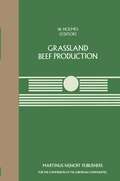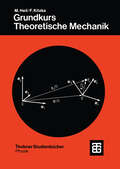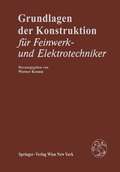- Table View
- List View
Graph Theory Singapore 1983: Proceedings of the First Southeast Asian Graph Theory Colloquium, Held in Singapore, May 10-28, 1983 (Lecture Notes in Mathematics #1073)
by H. P. Yap K. M. KohGrassland Beef Production: A Seminar in the CEC Programme of Coordination of Research on Beef Production, held at the Centre for European Agricultural Studies, Wye College (University of London), Ashford, Kent, UK, July 25–27, 1983 (Current Topics in Veterinary Medicine #28)
by W. HolmesGreat Reclothing of Rural England: Petty Chapman and their Wares in the Seventeenth Century
by Margaret SpuffordMargaret Spufford has written as detailed an account of the lives and activities of the chapmen as there is likely to be, given the widely-spread and fragmented evidence. She shows where and when they were active, and in particular their rise in the 17th century, their ranks and their typical careers, the variety of the cloths and other wares they carried, and the attitude of authority towards them.
Grenada: Revolution and Invasion (Routledge Library Editions: Revolution #13)
by Anthony Payne Paul Sutton Tony ThorndikeThis book, first published in 1984, analyses the background to the revolution in Grenada and details the course of its progress, examining the reasons why it faltered and failed. International factors played no small part in these events, setting the agenda for the internal processes of the revolution and bringing it to an end. The book also examines closely the US-led invasion of this tiny island and its aftermath.
Grenada: Revolution and Invasion (Routledge Library Editions: Revolution #13)
by Anthony Payne Paul Sutton Tony ThorndikeThis book, first published in 1984, analyses the background to the revolution in Grenada and details the course of its progress, examining the reasons why it faltered and failed. International factors played no small part in these events, setting the agenda for the internal processes of the revolution and bringing it to an end. The book also examines closely the US-led invasion of this tiny island and its aftermath.
Groups in Contact: The Psychology of Desegregation
by Norman S. Miller Marilynn B. BrewerGroups in Contact: The Psychology of Desegregation uses the contact hypothesis as a point of departure and provides new data obtained in a variety of social contexts. The contact hypothesis states that attitudes toward a disliked social group will become more positive with increased interpersonal interaction. The various chapters provide a picture of the desegregation process as a complex interplay between the cognitive processes within the individual and the structural features of the social environment. What emerges is an expanded theory of contact based on social categorization and social comparison processes. The book is organized into three parts. The chapters in Part I deal with issues of intergroup contact in a wide range of cultures and settings, each focusing on a particular social or political factor that influences receptivity to intergroup interaction and affects its outcomes. The chapters in Part II review the effects of specific interventions that have been introduced into desegregation settings with the intent of improving intergroup acceptance in those settings. Part III provides a systematic integration of the preceding chapters within a common theoretical framework. Although this book is written primarily from the perspective of social psychology, it is intended for students of intergroup relations in all disciplines. It was also written with policymakers, as well as social science researchers, in mind.
Groups - Korea 1983: Proceedings of a Conference on Combinatorial Group Theory held at Kyoungju, Korea, August 26-31, 1983 (Lecture Notes in Mathematics #1098)
by B. H. Neumann A. C. KimGrowth and Defect Structures (Crystals #10)
by H. C. FreyhardtPolytypic crystals of semiconductors, dielectrics and magnetic materials attract an increasing attention in science and technology. On one hand, the phenomenon of polyty pism is one of the fundamental problems of solid-state physics; its solution would make it possible to elucidate- the problem of the interconnection of different structures and intraatomic forces acting in crystals. On the other hand, the polytypic difference in crystals is most strongly expressed in electro-physical properties, which makes their application promising, mainly in semiconductor electronics. Thus, the difficulties of pro ducing modulated structures in polytypic crystals can be overcome since these crystals form a class of one-dimensional natural superlattices. At present it has become clear that polytypism in crystals and compounds is the rule rather than an exception and it is determined by the conditions of their synthesis. This phenomenon seems to be rather widespread in nature and fundamental for crystal forma tion. H polytypism was recently thought to be but a specific structural feature of a few substances such as SiC, ZnS, CdI , etc. , by now this phenomenon has been discovered in 2 v an increasing range of crystalline substances, for example, in silicon, diamond, AIIIB , VI AIIB , AIBVII compounds, in ternary semiconducting compounds, metals, silicates, perovskites, mica, organic crystals. The more accurately the structural studies are per formed, the greater is the number of crystals of various substances found to exhibit the phenomenon of polytypism. Recently, excellent surveys have systematized our knowledge of polytypism.
Growth, Cancer, and the Cell Cycle: The Molecular, Cellular, and Developmental Biology (Experimental Biology and Medicine #5)
by Philip Skehan Susan J. FriedmanGrundkurs Stochastik: Eine integrierte Einführung in Wahrscheinlichkeitstheorie und Mathematische Statistik (Teubner Studienbücher Mathematik)
by Konrad Behnen Georg NeuhausIn vielen Studienordnungen für das Mathematik-Studium an deut schen Hochschulen sind einführende Vorlesungen über Stochastik (Wahrscheinlichkeitstheorie und Mathematische Statistik) vorgese hen, an denen sowohl Hörer teilnehmen, die sich im Verlauf ihres Studiums verstärkt mit Stochastik befassen wollen, als auch solche, die sich anschließend anderen Bereichen der Mathematik zuwenden. Will man der ersten Gruppe gerecht werden, so liegt es nahe, zunächst systematisch ein maßtheoretisches Fundament zu schaffen, um erst danach zu den eigentlich stochastischen Fragestellungen überzuleiten. Hierbei kommt allerdings die zweite Gruppe zu kurz, die natürlicherweise dar an interessiert ist, einen bis zu einem gewissen Grad in sich abgeschlossenen Einblick in Denkweisen und Methoden der Stochastik zu erhalten, die jedoch kein Interesse dar an hat, einen Großteil der zur Verfügung stehenden Zeit einer sy stematischen Erarbeitung maßtheoretischer Grundlagen zu opfern. Viele Autoren haben den Bedürfnissen der letztgenannten Gruppe da durch Rechnung getragen, daß sie unter Verzicht auf maßtheoreti sche Begriffsbildungen die grundlegenden Ideen der Stochastik an hand spezieller Modelle, bei denen keine maßtheoretischen Kennt nisse benötigt werden, entwickeln. Aber auch diese Vorgehensweise birgt Nachteile: Solche, meist als "elementar" bezeichneten Darstellungen sind wenig praktikabel als Basis für weiterführende Veranstaltungen der Stochastik. Eini ge Mühe muß später darauf verwendet werden, die anhand von Spezial fällen entwickelten Begriffe in maßtheoretischem Gewand erneut zu formulieren und auf ihre Konsistenz mit den alten Begriffen zu überprüfen.
Grundlagen der Betriebswirtschaftslehre: Band 2: Der Absatz (Enzyklopädie der Rechts- und Staatswissenschaft #2)
by Erich GutenbergGrundlagen der elektrischen Meßtechnik (Leitfaden der Elektrotechnik)
by Heinrich Frohne Erwin UeckertGrundlagen der quantitativen Röntgen-Bildauswertung (Medizinische Informatik, Biometrie und Epidemiologie #55)
by K. Vanselow D. ProppeGrundlagen und praktische Anwendung der Röntgenfluoreszenzanalyse (RFA)
by Paula Hahn-WeinheimerDie moderne chemische Analytik macht in großem Umfang von instrumentellen physika lischen Methoden Gebrauch. Eine der leistungsfähigsten, und in ihrem Anwendungsbereich einzigartigen ist die Röntgenfluoreszenzanalyse (RF A). Sie verdankt dies vor allem den folgenden Eigenschaften: Sie ist zerstörungsfrei und benötigt wenig Probenmaterial. Es ist möglich, nahezu alle chemischen Elemente nachzuweisen; der Anwendungsbereich er~ streckt sich auf feste und flüssige Substanzen der verschiedensten Art. Die Möglichkeiten der RFA sind erst verhältnismäßig spät erkannt und verwirklicht wor den. Obwohl die Röntgenstrahlen bereits 1895 entdeckt worden waren, wurden erst Anfang der fünfziger Jahre brauchbare Analysengeräte auf den Markt gebracht, als die elektronische Meßtechnik genügend weit entwickelt war. Die Methode bürgerte sich ver hältnismäßig rasch ein, wobei zunächst als wesentliche Eigenschaft der RF A die erreich bare hohe Präzision galt. Im Lauf der weiteren Entwicklung gelang es mit Hilfe von sorg fältig ausgearbeiteten Korrekturverfahren eine nahezu ebenbürtige Genauigkeit zu er reichen. War zunächst die Bestimmung von mittleren und hohen Konzentrationen das Hauptanwendungsgebiet, so sind seitdem viele leistungsfähige Verfahren der Element spurenanalytik entwickelt worden. RF A wie kaum eine andere Analysenmethode. Von der Mikroelektronik profitierte die Röntgensequenz-und Simultanspektrometer werden durch Mikrocomputer gesteuert, die oft notwendige umfangreiche Datenverarbeitung erfolgt durch dedizierte Prozeßrechner. Dadurch ist es möglich, bei hohen Anforderungen an die Analysenqualität, Analysen' in großer Zahl wirtschaftlich durchzuführen. In der deutschsprachigen Literatur hat bis jetzt eine zusammenfassende Darstel1u~g der Röntgenfluoreszenzanalyse gefehlt, die diesem modernen Entwicklungsstand gerecht wird.























